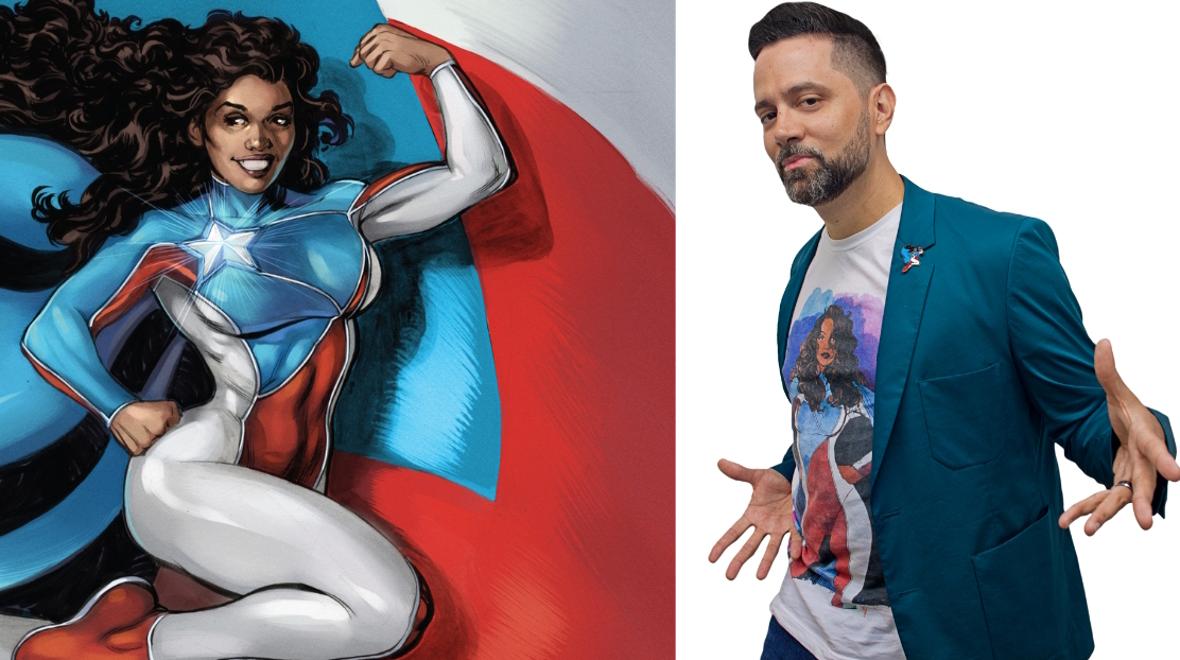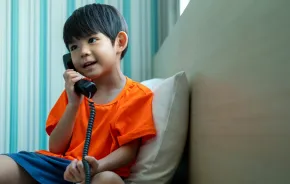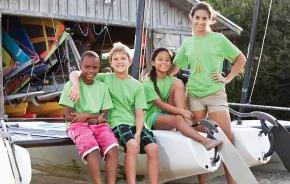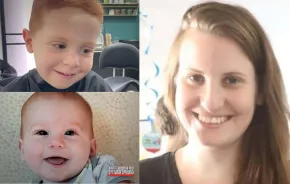
Photo:
La Borinqueña and writer and artist Edgardo Miranda-Rodriguez
Editor’s note: This article was sponsored by the Gates Foundation Discovery Center.
I’m a sucker for a good hero story. Maybe it’s because I taught Campbell’s hero cycle to Bellevue students for so many years, or that I saw “Star Wars” for the first time at an impressionable age. Or maybe it’s because hero stories are universally compelling and inspiring no matter what your stage of life.
In many ways epic hero tales have told the same story for generations. But by other accounts, they’re pushing boundaries and challenging notions of what it means to be a hero in their current iteration. Acclaimed writer and artist Edgardo Miranda-Rodriguez’s La Borinqueña is one such hero. At first glance, La Borinqueña has all the makings of a traditional superhero: superhuman strength, plus the ability to fly and control storms. But look beyond her red, white and blue spandex suit and she’s truly a nex-gen superhero.
Families will have a chance to hear from Miranda-Rodriguez at “Stories That Spark Change,” a Gates Foundation Discovery Center event and part of its celebration of Latine/Hispanic Heritage Month. The free event is open to the public and will be offered in-person Oct. 1, from 4–7 p.m., and online via Zoom (for registered participants). Food, music, gallery exploration and a book signing are all part of the evening’s plan.
To provide a little context for Miranda-Rodriguez’s visit, I sat down with him to learn about his work and passions. Here’s what he had to say.
How do you balance compelling storytelling with educating readers about important topics, such as social or environmental justice?
I have a bachelor’s degree in sociology and anthropology which gives me a distinct approach to storytelling. I research for every story that I write, reading articles, interviewing subjects, visiting museums, and I listen to Radio Universidad de Puerto Rico (public radio). My background as a community organizer and avid comic book reader also shaped me to be the writer I am today. At their core, I have always believed that superhero comic books are tethered to narratives of social justice and issues. When Jerry Siegel and Joel Schuster worked on the first adventure of Superman in 1938, the story tackled themes of domestic violence. On the cover of Jack Kirby and Joe Simon’s “Captain America #1,” the titular character is knocking out Adolf Hitler and the fascism his regime represented. Therefore, in “La Borinqueña” I bring in themes that affect the 3 million Puerto Ricans with U.S. citizenship living in the Caribbean archipelago. These themes are not unique to Puerto Rico, they are universal, which is why my stories resonate globally with readers. It wasn’t until Puerto Rico’s debt crisis in 2016 and Hurricane Maria in 2017 that mainstream audiences finally started taking notice of Puerto Rico. I hope that La Borinqueña’s graphic novels engage readers in stories that spark their imagination to learn more about Puerto Rico, its people, its struggles, and also to figure out ways to become involved.
As the saying goes, representation matters. How has the graphic novel/comic book industry evolved in terms of representation? And what still needs to be done to lift up diverse voices and experiences in the industry?
The mainstream publishing industry is still by and large represented by white male editors with the bulk of intellectual properties over the last 80 years being white men. There continues to be an overwhelming underrepresentation of BIPOC characters and experiences in mainstream publishing houses. We have been publishing our graphic novels independently for eight years now because we recognize the inherent value of stories that reflect our experiences in this nation that also have universal themes that all of us can relate to. On our own we have had a No. 1 bestselling book on Amazon (“Ricanstruction”), three of our books are part of the permanent collection of the Smithsonian (“La Borinqueña #1,” “Ricanstruction,” and “La Borinqueña Vol. 1”), a traveling art exhibition (San Juan, Puerto Rico; Lancaster, Pennsylvania; Long Island, NY; and Chicago, Illinois), and a line of action figures coming out this fall. We’re also the only superhero series dedicated to continued charity work having already awarded over $200,000 in grants to nonprofits in Puerto Rico. On our website we profile all of the nonprofits we support and do this to bring light to their truly superheroic work that inspires us to publish La Borinqueña’s stories.
La Borinqueña is often cited as a social justice hero. Why is Marisol Rios De La Luz the right character for this role?
Marisol Rios De La Luz, known as the La Borinqueña, is the superhero that we all need right now. As a character she represents the present and future of the world. A woman that is concerned about our environment. A citizen who stands up against government corruption. A student who believes in science. A granddaughter that cares for her grandparents. A friend who stands up for women’s health.
What’s one message you hope kids take with them after reading “La Borinqueña”?
We all have the power within ourselves to be a hero. We don’t need a cape. We don’t need superpowers. We need commitment, passion, and love in our hearts to become true heroes for justice. Children can see themselves in La Borinqueña because she’s a student who is still learning about her powers, her people, and her responsibility to her island nation of Puerto Rico.
What advice do you have for any young, aspiring graphic novelists or artists?
Storytelling, illustrating, and the act of creativity requires commitment, practice, and love. Many of us don’t always have the opportunity to create art for a living, but that should not stop us from creating for ourselves. Art and stories give us the ability to share with others how we see the world, and how we feel about being part of it. Write every day for yourself. Draw every day for yourself.
Other than your own work, do you have any graphic novel or comic book recommendations for kids?
Some great stories for children that I enjoyed are “Superman Smashes the Klan” by Gene Luen Yang; “Sí, Se Puede: The Latino Heroes Who Changed the United States” by Julia Anta; “Juliet Takes a Breath: The Graphic Novel” by Gabby Rivera; and “La Voz de M.A.Y.O. Tata Rambo” by Henry Barajas.
What’s something you hope to enjoy in Seattle during your time in the city?
I very much am excited about listening to Otoqui Reyes e Hijos de Agüeybaná live! I also am looking forward to having incredible conversations with Seattleites and enjoying some local Puerto Rican food from OSJ International!












